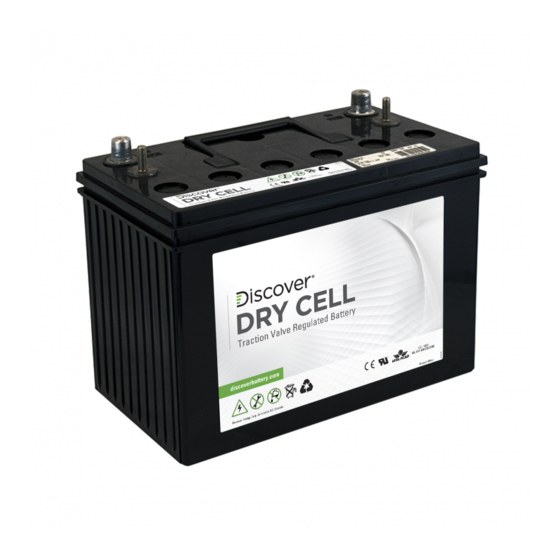
Summary of Contents for DISCOVER DRY CELL
-
Page 1: Table Of Contents
Operating Manual DRY CELL BATTERY BLOCKS 1. Safety 3.4 Parallel Connections 1.1 Warnings, Cautions and Notes 3.5 Series Connections 1.2 General Warning 3.6 Series/Parallel Connections 1.3 Fire Risk 3.7 Electrical Connections 1.4 Electric Shock Risk 4. Operation 1.5 Chemical Risk 4.1 Charging... - Page 2 • Analyzing and reducing hazards involved in performing electrical work • Installing and configuring batteries No responsibility is assumed by Discover for any consequences arising out of the use of this material. Visit discoverbattery.com for the most recent version of published documents.
-
Page 3: Safety
1. SAFETY 1.1 Warnings, Cautions, Notes and Symbols ▲ WARNING Important information regarding possible personal injury. ▲ CAUTION Important information regarding possible equipment damage. ▲ NOTE Additional information concerning important procedures and features of the battery. 1.2 General Warning ▲ CAUTION It is important to operate the battery with care to avoid undesirable consequences. -
Page 4: Do's
1.6 Do’s • Do protect terminals from short circuit before, during, and after installation • Do wear electrically insulated gloves • Do use electrically insulated tools • Do wear eye protection • Do wear safety toe boots / shoes • Do handle battery carefully •... -
Page 5: Unpacking And Handling
3.4 Parallel Connections Discover ® Solar Dry Cell may be connected in parallel to increase capacity, current capability and/or discharge durations. In the case of each parallel connected string, only use batteries of the same voltage, capacity, design and age. -
Page 6: Series Connections
3.5 Series Connections Discover Solar Dry Cell may be connected in series to increase system voltage. In the case of each series ® connected string, only use batteries of the same voltage, capacity, design and age. -
Page 7: Charging
(less than 1.5% rms voltage) of the DC System voltage with duration of less than 6 milliseconds. ▲ WARNING! Do not equalize charge DRY CELL Solar batteries! Equalizing is an “over voltage-over charge” performed on flooded leadacid batteries after they have been fully charged. -
Page 8: Commissioning Charge
By default, this may be set by power conversion manufacturer at 1.75 volts per cell (Vpc). Discover Dry Cell batteries deliver 50% of its rated capacity above 2.05 Vpc, this is also the recommended LVD to optimize battery runtime and longevity. -
Page 9: Charge Current Limits
Check for any visible defects such as cracks, loose terminal posts and oxidized connectors. To avoid leakage currents and the associated risk of fire, keep the battery dry and clean. Do not use any solvents or detergents. Avoid electrostatic charges. Discover Maintenance Logs are online available online. - Page 10 • Loose connections • Over-tightened connections • Improper sized cables (too small). • Corroded connections • Improper use of washers/lock washers. • Too many connections on the same terminal WHY DO THE BATTERIES BULGE? • Some case bulging can happen and is normal during battery charging. •...
- Page 11 WHAT DO I DO IF THE BATTERY IS FROZEN? Discover Dry Cell batteries can be stored in sub-freezing temperatures as low as 35 °C / -31°F as long as they are fully charged prior to storage. The self-discharge rate of fully-charged batteries is very low in these conditions and they will not require charging for many months.




Need help?
Do you have a question about the DRY CELL and is the answer not in the manual?
Questions and answers